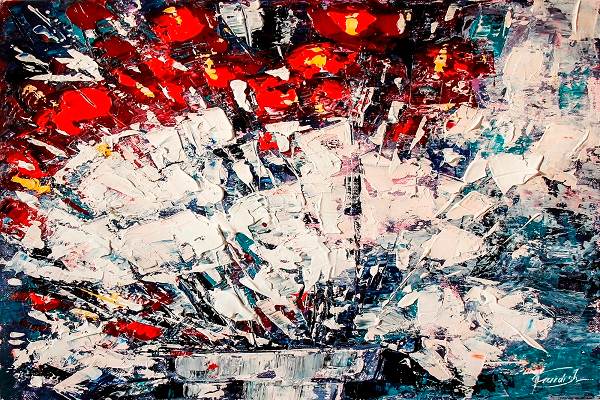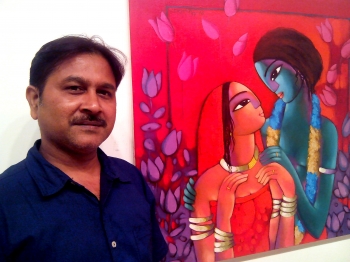
‘Abstract’ is defined as something existing in thought or as an idea but not having a concrete or physical existence. Abstract art traces back its origin to the nineteenth century in the west. It developed as a counterpart to the realism style which sought to paint on canvas as realistic and imagery as possible. Abstract art, in contrast, uses shapes, lines, form, color, and texture to create the desired effect. Artists delved into the existential issues of human life by experimenting with forms and styles. They tried to bring to life unconscious thoughts and dreams. Some surrealists invented games and techniques to quick start their imagination. They attempted to celebrate the ultimate human freedom. Abstract art changed the status quo in the art world- exposition dominating over expressive function- and it was a component of the larger change that was happening in the world during the nineteenth century.
Background
What led to abstraction? The nineteenth-century world experienced monumental changes in every aspect of life. There were great advances in the field of science and technology, society, politics, art, and culture. No aspect of life remained untouched by the sweeping changes that dawned upon humanity in the nineteenth century. Charles Darwin wrote the Origin of Species, first telephone call was made, railroads were laid across Europe, light bulb was invented, Beethoven premiered his Ninth Symphony, Jane Austen wrote Pride and Prejudice, first and second industrial revolution brought immense wealth, profit and popularity (sadly to a few people), Louis Pasteur discovered rabies’ vaccine, electromagnetism was advanced by Faraday, Ampere, and Maxwell, Sir Arthur Conan Doyle published his first Sherlock Story ‘A Study in Scarlet’, and population doubled in Europe, etc. The list is huge of the significant events that occurred in that era which shaped a lot of that followed. In this century of transformation, an interest in ‘invisible forces’ was widely accepted in the Western world. Radio waves, X-rays, and Gamma rays were discovered by the end of the century. These discoveries posed new questions for artists: is it possible to paint not just what the eyes perceive but what can be perceived by other senses like ears, intuition and the deep mind. Since then began the attempt to answer these question through abstract art.
Beginning
Wassily Kandinsky is regarded as the pioneer in the world of abstract paintings. He was a Russian painter and art theorist born in 1866. His ‘Untitled (Study for Composition VII, Première abstraction)’, painted in the year 1913 is regarded by many as the first abstract painting. However, a Swedish woman named Hilma Af Klint had created an abstract work, that can be deemed as the first of all the abstract paintings ever created, in her studio in 1906, five years before Kandinsky. She had a similar approach towards abstractionism even though she was completely unaware of Kandinsky’s existence. She studied at the Royal Academy of Fine Arts in Stockholm for five years and then leased a studio in the artist’s quarters in the city. Hilma got recognition as a landscape and portrait painter but she never put her abstract paintings for exhibition during her lifetime.
Also Read: Abstract Art - A kick to Human's Brain and Creativity
Development
Abstract paintings developed as an answer to the strict and severe representational approach in the art world of that time. Having felt confined within the strictness and severity of representational art, artists were spurred to break free, when they had accumulated enough courage in the backdrop of sweeping changes occurring in the entire world, from science to politics; their emotions, desires, fears, fantasies, and everything they had inside was poured out without foundation on canvas and this developed the concept of abstractionism.
- Firstly, a transition from realism to expressionism happened from 1830 to 1900. ‘Water Lily’ by Monet and ‘Nocturnes’ by James Abbot McNeill Whistler are two famous art pieces of this time.
- Post-impressionism developed as a reaction against the naturalism of impressionism. Vincent van Gogh, Paul Gauguin, and Paul Cezzane were pioneers of this movement. ‘Tahitian Woman’, ’Starry Nights’, and ‘The Basket of Apples’ are some of the artworks of this movement.
- Art Nouveau developed as an architecture, applied art, and decorative art style between 1890 and 1910. Natural forms and structures were its main theme. Antoni Gaudi who designed the world-renowned Sagrada Familia, situated in Barcelona, was a major proponent of this style in the Catalan region. Alphonse Mucha and Gustav Klimt are the two other famous men of this time. ‘Kiss’ by Klimt is an iconic work of this tradition.
- Cubism was developed by Pablo Picasso, Georges Braque, Fernand Leger, and Juan Gris, etc. Cubism has three branches- Proto-Cubist painting, Analytical Cubism, and Synthetic Cubism.
- Futurism was developed by Marinetti in Italy as a rejection of the traditional forms and an acknowledgement of modern science and technology.
- Action painting or gestural abstraction was made famous by the American painter Jackson Pollock. In this style, paint is applied to the canvas in a non-traditional way. The importance given to the act of painting is sometimes more than the result. The paint can be dribbled, smeared, splashed or poured on to the canvas. The physical involvement that this style need makes it an interestingly innovative technique to express.
- Surrealism, Futurism, Orphism, Rayonism, De Stijl, and Abstract Expressionism are an important part of this development process of modern abstract art style.
Abstract Art in India
This wave of creative expression, against the given backdrop, reached India in the years between 1960 and 1970. Slowly, Indian artists became a part of this modernist movement of abstract art. Jagdish Swaminathan and K.C.S. Paniker are early Indian artists of abstract genre in this movement whose work got widely recognized. Indian abstract art got highly influenced by Tantric forms in the middle years and many artists wrongly began to associate the sexual forms of tantric practices with modern abstract art. Prabhakar Kolte, Yashwant Deshmukh, S.H. Raza, F.N. Souza, Ram Kumar, Tyeb Mehta, and Makbool Fida Hussain added to the journey of abstract art in India creating famous compositions like ‘Birth of Poetry’, ‘Mother and Child’, and ‘Ankuran’.
Nobody knew in the beginning that this art movement would assume such importance in the future. Abstract paintings may not appeal to everyone, many people find them bizarre, obscene, and irrelevant. Several ‘artists’ have created obscure works in the name of abstract paintings and that has marred its ethos. Abstract paintings for sale, those hung in galleries, and the ones in the process of being made by artists aren’t always seen with a keen eye and curious emotion. This isn’t anyone’s fault. The intense engagement that an abstract artist has with the canvas is an expression of the profoundness of experience that he or she carries within. Abstract art is THE ART STYLE of the modern world for it is crowned by freedom of expression, the reigning emotion of the 21st century.





















